

WCF Data Services (formerly ADO.NET Data Services)
Redmond Review: Andrew Brust Likes What He Sees with OData. Redmond Review Open Data, Open Microsoft I've always been a data guy.
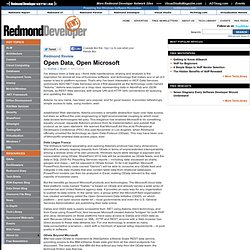
I think data maintenance, sharing and analysis is the inspiration for almost all line-of-business software, and technology that makes any or all of it easier is key to platform success. That's why I've been interested in WCF Data Services (previously ADO.NET Data Services) since it first appeared as the technology code-named "Astoria. " Astoria was based on a crisp idea: representing data in AtomPub and JSON formats, as REST Web services, with simple URI and HTTP verb conventions for querying and updating the data.
Astoria, by any name, has been very popular, and for good reason: It provides refreshingly simple access to data, using modern, well-
What is OData? What is OData?
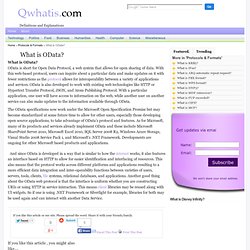
OData is short for Open Data Protocol, a web system that allows for open sharing of data. With this web-based protocol, users can inquire about a particular data and make updates on it with fewer restrictions as the protocol allows for interoperability between a variety of applications and services. OData is also developed to work with existing web technologies like HTTP or Hypertext Transfer Protocol, JSON, and Atom Publishing Protocol. With a particular application, one user will have access to information on the web, while another user on another service can also make updates to the information available through OData. The OData specifications now work under the Microsoft Open Specification Promise but may become standardized at some future time to allow for other users, especially those developing open source applications, to take advantage of OData’s protocol and features.
About This Post Posted by Erwin Z on Jun 10th, 2011 and filed under Protocols & Formats. OData Futures: creating the web of data. Ecosytem. OData by Example. Chris Sells March 2010 The purpose of the Open Data protocol[i] (hereafter referred to as OData) is to provide a REST-based protocol for CRUD-style operations (Create, Read, Update and Delete) against resources exposed as data services.
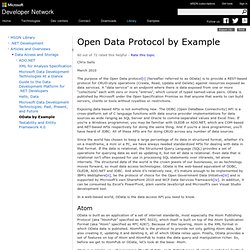
A “data service” is an endpoint where there is data exposed from one or more “collections” each with zero or more “entries”, which consist of typed named-value pairs. OData is published by Microsoft under the Open Specification Promise so that anyone that wants to can build servers, clients or tools without royalties or restrictions. Exposing data-based APIs is not something new. Since the world has chosen to keep a large percentage of its data in structured format, whether it’s on a mainframe, a mini or a PC, we have always needed standardized APIs for dealing with data in that format.
OData Projects - Interoperability Bridges and Labs Center. OData submitted to OASIS for standardization - Interoperability @ Microsoft. CRM 2011 OData Query Designer - Home. Silverlight 4 Netflix Browser - Home. OData Samples - Home. Entity framework, WCF and oData by example… A lot of functionality for ten minutes work... oData is an intriguing technology as it already provides metadata capabilities.

The related source code and runtime contain additional information and are a recommended companion to this post. The post only includes source code snippets of interest. Download the source code or runtime for this blog post. Preview the outcome of this blog post. Aim The aim of this adventure is to explore oData by creating a data service which exposes metadata, maintains its own database structure and allows for server side data querying. Ingredients .Net 4.0 (or 4.0.2 if using a Sql Server 2012 LocalDB)WCF Data Services 5.0 for OData V3Entity Framework 4.3.1 (included with related source code and runtime) Equipment Creating a model in the entity framework with code first As a spoiler, I’m creating a model in this post which will ultimately produce the following database structure.
The model consists of “plain old CLR objects” (POCO). // Represents a relationship, e.g. oData Metadata and jQuery by example… Querying oData metadata using jQuery, datajs and Knockout...

The oData protocol supports the transmission of data over HTTP using the AtomPub (XML) or JSON formats. The related source code and runtime contain additional information and are a recommended companion to this post. The post only includes source code snippets of interest. Download the source code or runtime for this blog post. Preview the outcome of this blog post. Aim The aim of this adventure is to consume and present metadata exposed by the oData service described in my last blog post using JavaScript and HTML.
Exposing Content as an OData feed. Microsoft.com Materials. OData – bondigeek.com. Browse by Tags - SQL Azure Team Blog. How to View Orchestrator Data by Using PowerPivot. Updated: November 1, 2013 Applies To: System Center 2012 - Orchestrator, System Center 2012 R2 Orchestrator, System Center 2012 SP1 - Orchestrator You can use Microsoft PowerPivot for Microsoft Excel to create reports for System Center 2012 - Orchestrator.
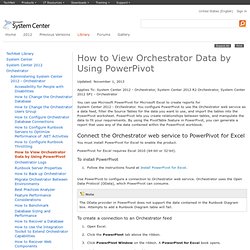
You configure PowerPivot to use the Orchestrator web service as a data feed, filter the Source Tables for the data you want to use, and import the tables into the PowerPivot worksheet. PowerPivot lets you create relationships between tables, and manipulate the data to fit your requirements. By using the PivotTable feature in PowerPivot, you can generate a report that uses any of the data contained within the PowerPivot workbook. Connect the Orchestrator web service to PowerPivot for Excel You must install PowerPivot for Excel to enable the product. PowerPivot for Excel requires Excel 2010 (64-bit or 32-bit). To install PowerPivot. Breaking Down ‘Data Silos’ – The Open Data Protocol (OData) - WCF Data Services Team Blog. Add Spark to Your OData: Consuming Data Services in Excel 2010 Part 1 - Beth Massi - Sharing the goodness. OData is an open REST-ful protocol for exposing and consuming data on the web.

Also known as Astoria, ADO.NET Data Services, now called WCF Data Services in .NET. I’ve written about it in the context of .NET many times on this blog. However there are SDKs available for other platforms like JavaScript and PHP. With the release of .NET Framework 3.5 Service Pack 1, .NET developers could easily create and expose data models on the web via REST. The simplicity of the service, along with the ease of developing it, make it very attractive for CRUD-style data-based applications to use as a service layer to their data. Now with .NET Framework 4, there are some new enhancements to data services (like my favorite) and as the technology matures, more and more data providers are popping up all over the web. Use the REST Endpoint for Web Resources. [Applies to: Microsoft Dynamics CRM 2011] The REST endpoint for web resources provides an alternative interface to work with Microsoft Dynamics CRM 2011 data.
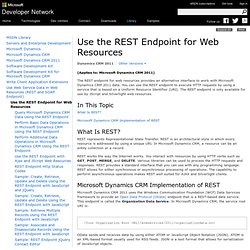
You can use the REST endpoint to execute HTTP requests by using a service that is based on a Uniform Resource Identifier (URI). The REST endpoint is only available for use by JScript and Silverlight web resources. In This Topic. Odata - MSDN Search. MSDN Blogs. OData and OAuth – protecting an OData Service using OAuth 2.0 - WCF Data Services Team Blog. In this post you will learn how to create an OData service that is protected using OAuth 2.0, which is the OData team’s official recommendation in these scenarios: Delegation: In a delegation scenario a third party (generally an application) is granted access to a user’s resources without the user disclosing their credentials (username and password) to the third party.
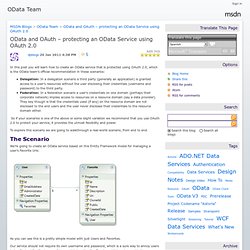
Federation: In a federation scenario a user’s credentials on one domain (perhaps their corporate network) implies access to resources on a resource domain (say a data provider). They key though is that the credentials used (if any) on the resource domain are not disclosed to the end users and the user never discloses their credentials to the resource domain either. So if your scenarios is one of the above or some slight variation we recommend that you use OAuth 2.0 to protect your service, it provides the utmost flexibility and power. MSDN Blogs. Today we are announcing a new project called ‘datajs’, a cross-browser JavaScript library that enables web applications to do more with data. datajs leverages modern protocols such as JSON and OData as well as HTML5-enabled browser features.
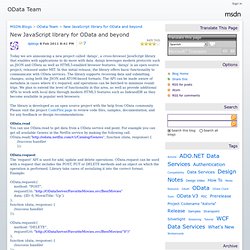
‘datajs’ is an open source project, released under MIT. In this initial release, the library offers basic functionality to communicate with OData services. The library supports receiving data and submitting changes, using both the JSON and ATOM-based formats. The API can be made aware of metadata in cases where it's required, and operations can be batched to minimize round-trips. We plan to extend the level of functionality in this area, as well as provide additional APIs to work with local data through modern HTML5 features such as IndexedDB as they become available in popular web browsers. The library is developed as an open source project with the help from OData community. WCF Data Services Team Blog. OData Viewer Tool - Home. Windows Azure SQL - Home. Silverlight Data Source Control for OData - Home. Data Workflow Activities - Home. Open Data Protocol Q&A.
Q: What is the Open Data Protocol? A: The Open Data Protocol (OData) is a web protocol for querying and updating data. OData applies web technologies such as HTTP, Atom Publishing Protocol (AtomPub) and JSON to provide access to information from a variety of applications, services, and stores. OData emerged organically based on the experiences implementing AtomPub clients and servers in a variety of products over the past several years. OData is being used to expose and access information from a variety of sources, including but not limited to relational databases, file systems, content management systems, and traditional web sites.